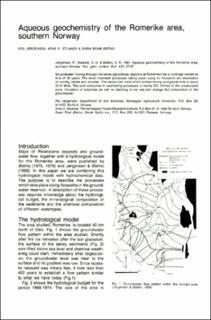| dc.contributor.author | Jørgensen, Per | |
| dc.contributor.author | Østmo, Svein Roar | |
| dc.contributor.author | Stuanes, Arne O. | |
| dc.date.accessioned | 2020-08-26T09:07:36Z | |
| dc.date.available | 2020-08-26T09:07:36Z | |
| dc.date.issued | 1990 | |
| dc.identifier.uri | https://hdl.handle.net/11250/2674192 | |
| dc.description.abstract | Groundwater flowing through the sandy glaciofluvial deposits at Romerike has an average residence time of 30 years. The most important processes taking place along its flowpaths are dissolution of low-Mg calcite and sillicates. The decalcified zone which formed during postglacial time is about 10 m thick. The acid consumed in weathering processes is mainly CO2 formed in the unsaturated zone. Oxidation of sulphides as well as leaching of old sea salt change the composition of the groundwater. | |
| dc.language.iso | nor | |
| dc.relation.ispartofseries | NGU Bulletin (420) | |
| dc.rights | Navngivelse 4.0 Internasjonal | |
| dc.rights.uri | http://creativecommons.org/licenses/by/4.0/deed.no | |
| dc.subject | GRUNNVANN | |
| dc.title | Aqueous geochemistry of the Romerike area, southern Norway | |
| dc.type | Journal article | |
| dc.description.localcode | 36268 | |
| dc.source.pagenumber | 57-67 | |

